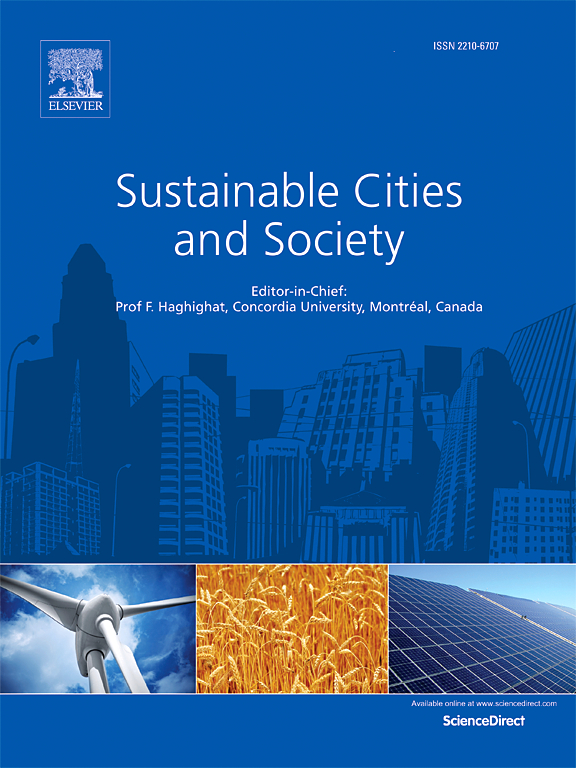Mitigation pathways of urban heat islands and simulation of their effectiveness from a perspective of connectivity
IF 10.5
1区 工程技术
Q1 CONSTRUCTION & BUILDING TECHNOLOGY
引用次数: 0
Abstract
Several studies have proposed strategies to alleviate the urban heat island (UHI) amidst the challenges of global warming and rapid urbanization. Though, few have explored multi-network synergies of heat and cold islands and simulation of their effectiveness. This study constructed an urban thermal environment (UTE) network by 2D and 3D urban structural parameters from a perspective of connectivity. Cooling measures are proposed to mitigate the UHI by combining forward and reverse thinking. The thermal environment is simulated using the patch-generating land use simulation (PLUS) model to assess the effectiveness of the cooling network. Firstly, morphological spatial pattern analysis (MSPA) and connectivity analysis are used to identify urban cold and heat island sources. Then, thermal resistance is constructed by 2D and 3D structural parameters. A multi-level thermal environment network is generated through the minimum cumulative resistance (MCR) model and circuit theory. Subsequently, key nodes within this network are identified. Finally, the PLUS model simulates and compares the thermal environment before and after the implemented of cooling network. Taking Fuzhou City as an instance, we find that: (1) 43 cold island sources, 28 heat island sources, 196 cooling corridors, 64 heat island corridors, and 711 thermal environment spatial network pinch-points are identified. (2) The PLUS model demonstrates an overall accuracy of 78% in simulating the 2023 thermal environment, affirming the feasibility of UTE simulation. (3) After optimization, the growth rate of the low-temperature zone increased by 60.63% while the growth rate of the high-temperature zone decreased by 8.63%, indicating the effectiveness of the proposed multi-level cooling network in mitigating the UHI. The approach presented in this research provides new insights for sustainable urban development and climate adaptation planning, and is crucial for addressing the UHI.
求助全文
约1分钟内获得全文
求助全文
来源期刊

Sustainable Cities and Society
Social Sciences-Geography, Planning and Development
CiteScore
22.00
自引率
13.70%
发文量
810
审稿时长
27 days
期刊介绍:
Sustainable Cities and Society (SCS) is an international journal that focuses on fundamental and applied research to promote environmentally sustainable and socially resilient cities. The journal welcomes cross-cutting, multi-disciplinary research in various areas, including:
1. Smart cities and resilient environments;
2. Alternative/clean energy sources, energy distribution, distributed energy generation, and energy demand reduction/management;
3. Monitoring and improving air quality in built environment and cities (e.g., healthy built environment and air quality management);
4. Energy efficient, low/zero carbon, and green buildings/communities;
5. Climate change mitigation and adaptation in urban environments;
6. Green infrastructure and BMPs;
7. Environmental Footprint accounting and management;
8. Urban agriculture and forestry;
9. ICT, smart grid and intelligent infrastructure;
10. Urban design/planning, regulations, legislation, certification, economics, and policy;
11. Social aspects, impacts and resiliency of cities;
12. Behavior monitoring, analysis and change within urban communities;
13. Health monitoring and improvement;
14. Nexus issues related to sustainable cities and societies;
15. Smart city governance;
16. Decision Support Systems for trade-off and uncertainty analysis for improved management of cities and society;
17. Big data, machine learning, and artificial intelligence applications and case studies;
18. Critical infrastructure protection, including security, privacy, forensics, and reliability issues of cyber-physical systems.
19. Water footprint reduction and urban water distribution, harvesting, treatment, reuse and management;
20. Waste reduction and recycling;
21. Wastewater collection, treatment and recycling;
22. Smart, clean and healthy transportation systems and infrastructure;
 求助内容:
求助内容: 应助结果提醒方式:
应助结果提醒方式:


